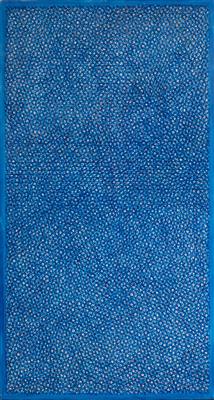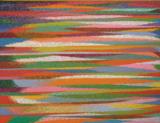Piero Dorazio *

(Rome 1927–2005 Perugia)
Il bello blu, 1961, signed, dated and titled on the reverse, oil on canvas, 130 x 70 cm, framed
This work is registered in the Associazione Archivio Piero Dorazio, Milan and is accompanied by a photo certificate of authenticity
Provenance:
Marlborough Gallery, Rome (label on the reverse)
Benito Storni Collection, Florence
European Private Collection
Exhibited:
Basel, Art Basel,1980, Galleria De Amicis Florence (label on the reverse)
Space can be represented with a bundle of coloured string as the Indians did, or as Ptolemy, Copernicus, or Descartes did. You can do it with a system of points, lines or planes or with a large number of qualified energies, like Galileo, Newton, and Einstein. But space can also be represented as it was in Pompeii, in the paintings of Tintoretto or de Seurat: with volumes, surfaces, and lines, or as was done in Athens, Mexico, and Japan.
Scientists and technicians represent space in a more modern way, with structures and structural systems, in which energy and space coexist. However, none of these scientific abstractions of the natural phenomenon of 'space' can provide sufficient knowledge of the unpredictable presence of man with his different modes of expression. I think that one cannot, either visually or conceptually, understand the connection between man and space without the help of colour, and this can only be done through painting. [...]
Instead, the creative painter is able to produce entirely new phenomena that are realistic substitutes for what is found in the less obvious parts of nature, such as silence, fury, integrity, calm, joy, or light. Colour therefore makes it possible to bring out images of 'space' that are more directly related to our immediate ways of perceiving, of detecting our position in space; of allowing our senses of the opportunity to guess what we are and what space we occupy.
It is not a question of showing our position in relation to space through an interpretation of something, be it an object or an ideal. We are free not to use colour as a means of interpretation: we can use it instead to mitigate our false impressions of how we are used to perceiving, reacting and seeing. We can use it to extend and augment our natural aptitudes to guess and interpret the incoming signals of an ever-changing world. How to use tools, how to use colour; this is what every painter tries to discover through anticipation and disappointment.
Many of the problems debated in painting today could be identified and understood through the "ways" in which colour is used, or rather the "new ways" in which colour is used. [...]
I personally dream of "a method" of using colour in which technique and poetry can be interwoven together, in a combination of levels of "colour-experience".
The process through which images and final values are produced should be readable and reversible from beginning to end. The rhythm of the working process should add to the objective nature of colour, the expressive element of time and scale. Through colour we can present a sense of space that could itself be a living reality, in which others are able to understand that life is development and that progress always takes on a new image.
(Piero Dorazio, in the catalogue of the exhibition 'Komplexe Farbe' at the Galerie Anna Roepcke in Wiesbaden, Germany 1962)
Esperto: Alessandro Rizzi
 Alessandro Rizzi
Alessandro Rizzi
+39-02-303 52 41
alessandro.rizzi@dorotheum.it
23.06.2021 - 16:00
- Prezzo realizzato: **
-
EUR 454.700,-
- Stima:
-
EUR 120.000,- a EUR 160.000,-
Piero Dorazio *
(Rome 1927–2005 Perugia)
Il bello blu, 1961, signed, dated and titled on the reverse, oil on canvas, 130 x 70 cm, framed
This work is registered in the Associazione Archivio Piero Dorazio, Milan and is accompanied by a photo certificate of authenticity
Provenance:
Marlborough Gallery, Rome (label on the reverse)
Benito Storni Collection, Florence
European Private Collection
Exhibited:
Basel, Art Basel,1980, Galleria De Amicis Florence (label on the reverse)
Space can be represented with a bundle of coloured string as the Indians did, or as Ptolemy, Copernicus, or Descartes did. You can do it with a system of points, lines or planes or with a large number of qualified energies, like Galileo, Newton, and Einstein. But space can also be represented as it was in Pompeii, in the paintings of Tintoretto or de Seurat: with volumes, surfaces, and lines, or as was done in Athens, Mexico, and Japan.
Scientists and technicians represent space in a more modern way, with structures and structural systems, in which energy and space coexist. However, none of these scientific abstractions of the natural phenomenon of 'space' can provide sufficient knowledge of the unpredictable presence of man with his different modes of expression. I think that one cannot, either visually or conceptually, understand the connection between man and space without the help of colour, and this can only be done through painting. [...]
Instead, the creative painter is able to produce entirely new phenomena that are realistic substitutes for what is found in the less obvious parts of nature, such as silence, fury, integrity, calm, joy, or light. Colour therefore makes it possible to bring out images of 'space' that are more directly related to our immediate ways of perceiving, of detecting our position in space; of allowing our senses of the opportunity to guess what we are and what space we occupy.
It is not a question of showing our position in relation to space through an interpretation of something, be it an object or an ideal. We are free not to use colour as a means of interpretation: we can use it instead to mitigate our false impressions of how we are used to perceiving, reacting and seeing. We can use it to extend and augment our natural aptitudes to guess and interpret the incoming signals of an ever-changing world. How to use tools, how to use colour; this is what every painter tries to discover through anticipation and disappointment.
Many of the problems debated in painting today could be identified and understood through the "ways" in which colour is used, or rather the "new ways" in which colour is used. [...]
I personally dream of "a method" of using colour in which technique and poetry can be interwoven together, in a combination of levels of "colour-experience".
The process through which images and final values are produced should be readable and reversible from beginning to end. The rhythm of the working process should add to the objective nature of colour, the expressive element of time and scale. Through colour we can present a sense of space that could itself be a living reality, in which others are able to understand that life is development and that progress always takes on a new image.
(Piero Dorazio, in the catalogue of the exhibition 'Komplexe Farbe' at the Galerie Anna Roepcke in Wiesbaden, Germany 1962)
Esperto: Alessandro Rizzi
 Alessandro Rizzi
Alessandro Rizzi
+39-02-303 52 41
alessandro.rizzi@dorotheum.it
|
Hotline dell'acquirente
lun-ven: 10.00 - 17.00
kundendienst@dorotheum.at +43 1 515 60 200 |
| Asta: | Arte contemporanea I |
| Tipo d'asta: | Asta in sala con Live Bidding |
| Data: | 23.06.2021 - 16:00 |
| Luogo dell'asta: | Wien | Palais Dorotheum |
| Esposizione: | 17.06. - 23.06.2021 |
** Prezzo d'acquisto comprensivo di tassa di vendita e IVA
Non è più possibile effettuare un ordine di acquisto su Internet. L'asta è in preparazione o è già stata eseguita.
Altri oggetti dell'artista
-

Stima:
EUR 60.000,- a EUR 80.000,- -

Stima:
EUR 20.000,- a EUR 30.000,-
